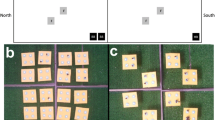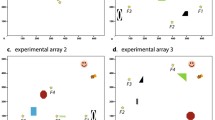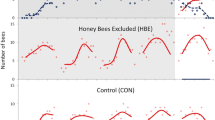Summary
The time required for a bumble bee to visit a flower is affected by the length of the bee's glossa and its body weight, and by the depth of the flower and the volume of nectar it contains. Probing time is comprised of two components: access time and ingestion time. Access time increases linearly with flower depth, but ingestion time varies with flower depth only in flowers deeper than the length of the bee's glossa, due to a decline in the rate of ingestion of nectar. Probing time therefore increases gradually with increasing depth for flowers shallower than the bee's glossa, but beyond that depth it increases much more rapidly. The relation of probing time to flower depth influences the foraging efficiency and choice of flowers by bumble bees.
Similar content being viewed by others
References
Abbott IJ, Abbott LK, Grant PR (1975) Seed selection and handling ability of four species of Darwin's finches. Condor 77:332–335
Brian AD (1957) Differences in the flowers visited by four species of bumble-bees and their causes. J Anim Ecol 26:71–98
Craig RB (1978) An analysis of the predatory behavior of the loggerhead shrike. Auk 95:221–234
Dixon AFG (1959) An experimental study of the searching behaviour of the predatory coccinellid beetle Adalia decempunctata (L.). J Anim Ecol 28:259–281
Grant PR, Grant BR, Smith JNM, Abbott JJ, Abbott LK (1976) Darwin's finches: Population variation and natural selection. Proc Nat Acad Sci USA 73:257–261
Hainsworth FR (1973) On the tongue of a hummingbird: Its role in the rate and energetics of feeding. Comp Biochem Physiol 46A:65–78
Hainsworth FR, Wolf LL (1976) Nectar characteristics and food selection by hummingbirds. Oecologia (Berlin) 25:101–113
Harder LD (1982) Measurement and estimation of functional proboscis length in bumblebees (Hymenoptera; Apidae). Can J Zool 60:1073–1079
Heinrich B (1976) Resource partitioning among some eusocial insects: bumblebees. Ecology 57:874–889
Hodges CM, Wolf LL (1981) Optimal foraging in bumblebees: Why is nectar left behind in flowers? Behav Ecol Sociobiol 9:41–44
Holm SN (1966) The utilization and management of bumble bees for red clover and alfalfa seed production. Ann Rev Ent 11:155–182
Inouye DW (1980) The effect of proboscis and corolla tube lengths on patterns and rates of flower visitation by bumblebees. Oecologia (Berlin) 45:197–201
Macior LW (1974) Pollination ecology of the Front Range of the Colorado Rocky Mountains. Melanderia 15:1–59
Menge JL (1974) Prey selection and foraging period of the predaceous rocky intertidal snail, Acanthina punculata. Oecologia (Berlin) 17:293–316
Mittelbach GG (1981) Foraging efficiency and body size: a study of optimal diet and habitat use by bluegills. Ecology 62:1370–1386
Plowright RC, Jay SC (1966) Rearing bumble bee colonies in captivity. J Apicult Res 5:155–165
Pomeroy N, Plowright RC (1980) Maintenance of bumble bee colonies in observation hives (Hymenoptera: Apidae). Can Ent 112:321–326
Pyke GH (1978) Optimal body size in bumblebees. Oecologia (Berlin) 34:255–266
Ranta E, Lundberg H (1980) Resource partitioning in bumblebees: the significance of differences in proboscis length. Oikos 35:298–302
Salt GW, Willard DE (1971) The hunting behavior and success of Forester's tern. Ecology 52:989–998
Schlamowitz R, Hainsworth FR, Wolf LL (1976) On the tongues of sunbirds. Condor 78:104–107
Schoener TW (1969) Models of optimal size for solitary predators. Am Nat 103:277–313
Stapel C (1933) Undersøgelser over humlebier (Bombus Latr.), deres udbredelse, traekplanter og betydning for bestøningen af rødkløver (Trifolium pratense L.). Tidsskr Planteavl 39:193–294
Teräs I (1976) Flower visits of bumblebees, Bombus Latr. (Hymenoptera, Apidae), during one summer. Ann Zool Fennici 13:200–232
Thomson JD, Plowright RC (1980) Pollen carryover, nectar rewards, and pollinator behavior with special reference to Diervilla lonicera. Oecologia (Berlin) 46:68–74
Author information
Authors and Affiliations
Rights and permissions
About this article
Cite this article
Harder, L.D. Flower handling efficiency of bumble bees: morphological aspects of probing time. Oecologia 57, 274–280 (1983). https://doi.org/10.1007/BF00379591
Received:
Issue Date:
DOI: https://doi.org/10.1007/BF00379591




